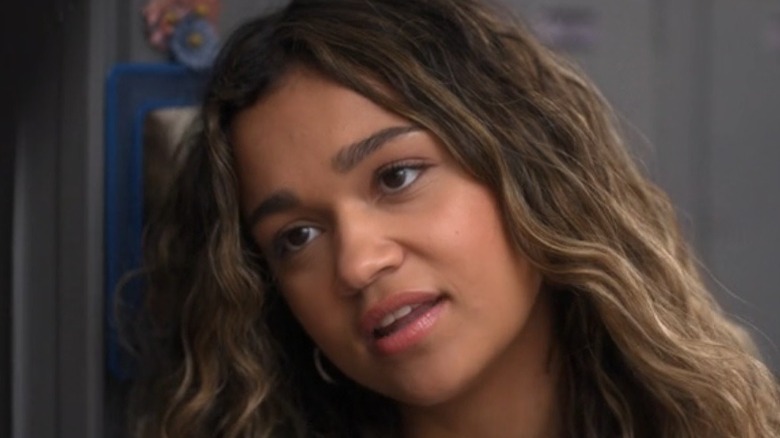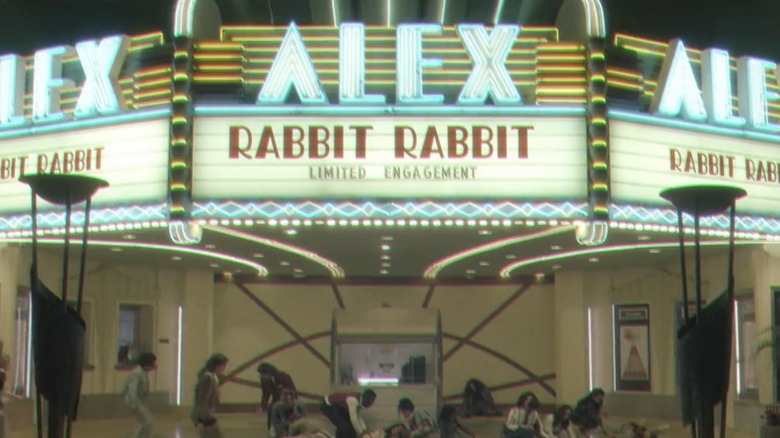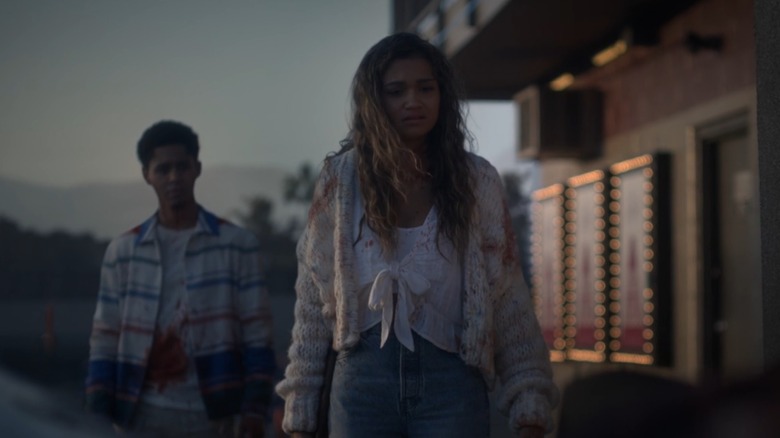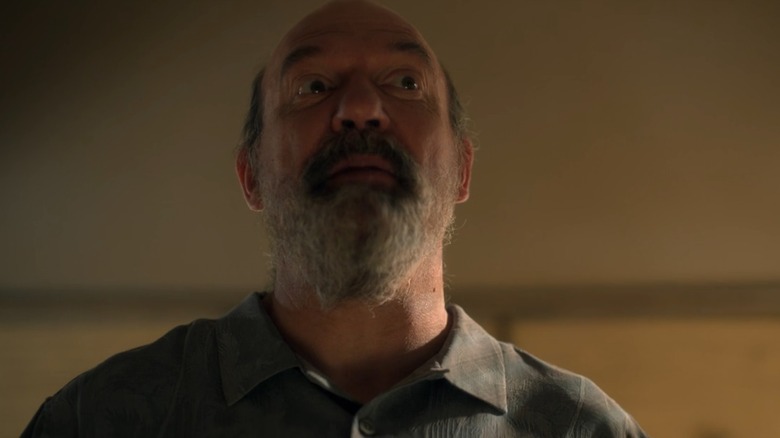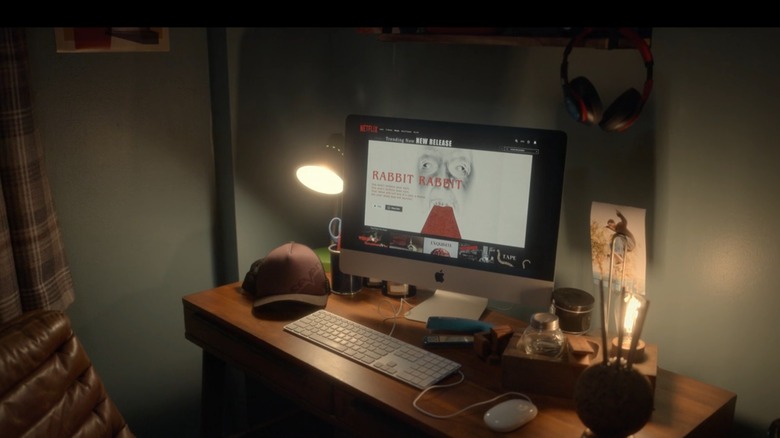American Horror Stories: Drive In Ending Explained
Have you ever seen a movie so scary that it affected you long after you left the theater? One that had you losing sleep, afraid to walk down a dark hallway, or giving your friends looks of suspicion? The moment when a film transcends the medium and manifests its horrors in the real world is the subject of "American Horror Stories: Drive In." But in this tale of terror, the bleeding between a work of fiction and the physical world is much, much more literal.
The protagonists of "Drive In" are Kelley (Madison Bailey) and Chad (Rhenzy Feliz), a young couple who have yet to consummate their relationship. Looking for a way to get Kelley in a more intimate mood, Chad decides to take his friend's advice and invite her to a screening of an infamous horror movie called "Rabbit Rabbit."
The film only ever played once, an event that led to the deaths of numerous people and the director being thrown in prison. While every copy of the movie was thought to have been destroyed, a new print has surfaced and is slated to be shown at a local drive-in. The event is not only an opportunity to bear witness to cinema history but Chad also hopes the notoriously scary flick will send Kelley proverbially running into his arms.
However, they will come to find out that there was a good reason that "Rabbit Rabbit" was destroyed. Unfortunately for Chad, Kelley, and their friends, by the time they realize this, it's far too late.
Drive In is steeped in horror cinema history
While the plot of "Drive In" is relatively straightforward, the episode does offer several meta-levels of storytelling. The history of horror cinema is full of urban legends about movies like the fictional "Rabbit Rabbit" that were reported to either be real or so scary that they harmed the audience.
The director of the early found-footage splatter film "Cannibal Holocaust" had to bring the cast of his movie to court to prove that he hadn't actually murdered them. The 1975 movie "Snuff" was marketed as a genuine snuff film that had been brought to the US from South America, a claim that was allegedly investigated by law enforcement (via ComingSoon). We could even look as far back as the urban legend about a screening of the 1896 film "Arrival of a Train at La Ciotat" which supposedly caused audience members to run from the theater because they thought they were about to be struck down by an actual train (via Slate).
In "Drive In," the characters view the reputation of "Rabbit Rabbit" as another one of these stories, and when a woman claiming to be an original victim of the film shows up at the screening, they assume she was hired as a publicity stunt. This is "American Horror Stories," though, and the urban legend turns out to be true. However, while the violent monsters the movie turns its audience members into are scary on their own, you could make the argument that the real horror at play is the seductive nature of a piece of art banned or destroyed for being too dangerous.
It sounds like the easiest thing in the world to avoid becoming the victim of a cursed film, but as the end of the episode demonstrates, the allure of such a story is often too powerful to resist.
Kelley and Chad survive by subverting a major horror movie trope
In "Scream," a horror movie famous for its meta-commentary on horror movies, the cinema-buff character Randy (Jamie Kennedy) lays down a list of rules for how to survive a slasher film. Rule number 1? "You can never have sex ... sex equals death."
The "sin factor" as he calls it is indeed something you see often in these types of movies, where characters who sneak off to fool around or do drugs are killed while the virtuous and rule-abiding ones live. "Drive In" subverts that trope with the characters of Kelley and Chad.
Much of the first part of the episode centers around the question of whether they will finally consummate their relationship. Chad is eager, if not a little bit nervous, while Kelley is waiting for the right moment, but worried that she's letting her fear get the better of her. When they finally do make it to the darkness of the drive in, they're both in a place where they are ready to seal the deal. And that's ultimately what ends up saving them.
Kelley and Chad begin fooling around before the movie even begins in earnest and their fogged-up car windows obscure their view of the nightmarish film. While everyone else at the drive in is transformed into a demonic creature that violently attacks anyone they see, they are spared. Unlike the slasher movies of old, choosing to fool around ends up saving Kelley and Chad's lives (although, it didn't help their similarly randy friends).
After escaping the screening, Kelley and Chad manage to find the director of "Rabbit Rabbit," Larry Bitterman (John Carroll Lynch), at his trailer home in the desert where they hold him at gunpoint and force him to explain how and why he unleashed this horror onto the world.
The truth behind Rabbit Rabbit
When Bitterman hears about the totality of the destruction "Rabbit Rabbit" caused, he's elated. He says of the film, "It's an experience. It's a cinematic happening. A horror movie where the horror isn't on screen. It's in the audience."
It's revealed that Bitterman worked on "The Exorcist" and was allegedly responsible for the flashes of demonic imagery that the film famously contains. He then turned those techniques up to the max and worked to create a movie full of subliminal sound and imagery so powerful it could manifest the horror into reality. To look at it from his perspective, Bitterman's project was a major success.
But pure auteur ego isn't the only thing driving the director. In a flashback, we learn that he became the subject of a heated censorship campaign headed by Tipper Gore (Amy Grabow), the wife of former Vice President Al Gore who is known, among other things, for being instrumental in the creation of Parental Advisory stickers. Bitterman was ultimately jailed for attacking Gore during a congressional hearing and in the present, he defends his assault and his literally violent art by declaring, "A society that locks up its artists doesn't deserve to survive."
As an archetype, Bitterman is a bit like a superhero movie villain: someone who feels that they were wronged and decides to burn everything down rather than work to make it better. His plan for "Rabbit Rabbit" would make the Joker jealous for the way it cruelly preys on humanity's instinctual curiosity. Like the best villains, his arguments are sometimes compelling, but his actions are truly sinister.
And as we see in the episode's twist ending, if Bitterman's goal was to get as many people as possible to see the movie, he found the perfect way to succeed.
Drive In has a sinister twist ending
After incapacitating Bitterman with a shotgun blast to the legs and burning the only remaining copy of "Rabbit Rabbit," Kelley and Chad flee his trailer. However, the director has an ominous warning for them as they go: "You think this is the end of the movie? It's only act one ... I've got a f—ing Rolls. You want to know why? ... You won't like the f—ing answer!"
At first, Bitterman's threats and boasts about the Rolls Royce we can see parked outside of his trailer seem like little more than the ramblings of a desperate man. However, in the final moments of the episode, we do indeed get an answer to how he was suddenly able to afford such an expensive car.
In the last scene of the episode, we're back in Chad's bedroom. The young couple is making out on his bed, but instead of lingering on them, the camera slowly zooms in on his computer. The Netflix home screen is pulled up and what is the top advertised movie? "Rabbit Rabbit." Outside, we hear the sounds of rioting and explosions as the film infects the masses with Bitterman's cinematic horror.
In securing himself a lucrative deal with Netflix, Bitterman's evil plan also reaches the zenith of its power. Buying a ticket and physically going to a movie theater is enough of a barrier for some to resist the urge of his cursed film. But now that it's available on streaming, anybody who feels curious can indulge.
